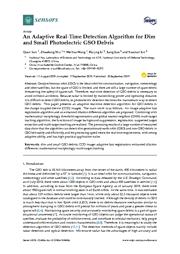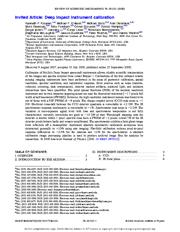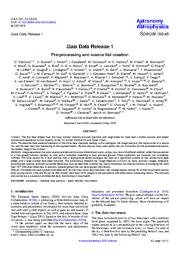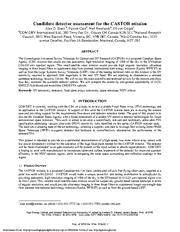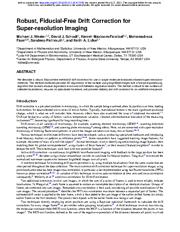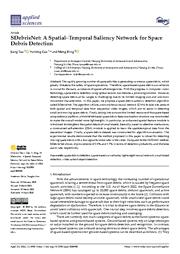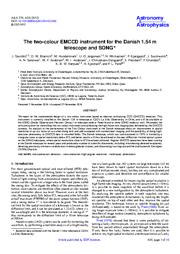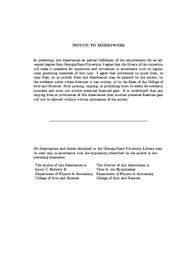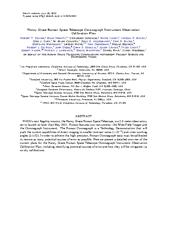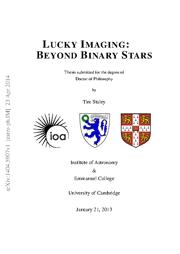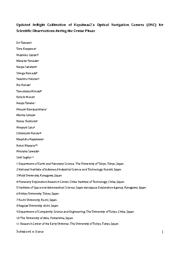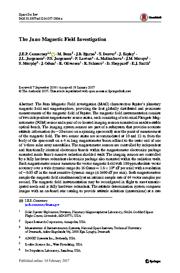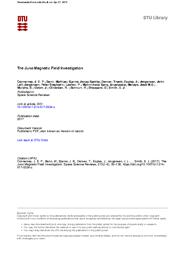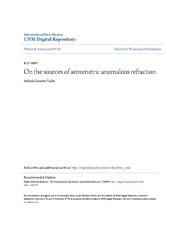A copy of this work was available on the public web and has been preserved in the Wayback Machine. The capture dates from 2020; you can also visit the original URL.
The file type is application/pdf.
Filters
An Adaptive Real-Time Detection Algorithm for Dim and Small Photoelectric GSO Debris
2019
Sensors
This paper presents an adaptive real-time detection algorithm for GSO debris in the charge coupled device (CCD) images. ...
Geosynchronous orbit (GSO) is the ideal orbit for communication, navigation, meteorology and other satellites, but the space of GSO is limited, and there are still a large number of space debris threatening ...
Acknowledgments: The authors would like to thank the editor and the anonymous reviewers for their valuable comments and suggestions. ...
doi:10.3390/s19184026
fatcat:fgmxqlncjfddnik4e37tzvpew4
Invited Article: Deep Impact instrument calibration
2008
Review of Scientific Instruments
The impactor weighed 364 kg and carried a charge-coupled device ͑CCD͒ camera ͑described in Sec. ...
However, the high resolution instrument camera was found to be out of focus with a PSF FWHM of ϳ9 pixels. The charge coupled device ͑CCD͒ read noise is ϳ1 DN. ...
doi:10.1063/1.2972112
pmid:19044397
fatcat:sqzedgd4hfcjpedywmhrhpwtii
GaiaData Release 1
2016
Astronomy and Astrophysics
Image parameters for point sources are derived from one-dimensional scans, using a maximum likelihood method, under the assumption of a line spread function constant in time, and a complete modelling of ...
The autonomous onboard star image detection will pick up many spurious images, especially around bright sources, and such unwanted detections must be identified. ...
Ciência e a Tecnologia through the contract Ciência2007 and project grant PTDC/CTE-SPA/118692/2010. ...
doi:10.1051/0004-6361/201628643
fatcat:onpnulcl5zhbfi7m2bo74ff6ky
Candidate detector assessment for the CASTOR mission
2014
High Energy, Optical, and Infrared Detectors for Astronomy VI
The Cosmological Advanced Survey Telescope for Optical and UV Research (CASTOR) is a proposed Canadian Space Agency (CSA) mission that would provide panoramic, high-resolution imaging of 1/8th of the sky ...
We are planning to characterize a selected candidate technology down to 150 nm. ...
A couple of European companies have been developing back-thinning and surface passivation methods for large format NUV BICMOS detectors for the proposed ESA Solar Orbiter mission 9, 10 . ...
doi:10.1117/12.2057033
fatcat:tpv42qh6ffa3jbt4ryscot3lra
Brighter-fatter effect in near-infrared detectors – I. Theory of flat auto-correlations
[article]
2019
arXiv
pre-print
One of the non-linear detector effects observed in CCDs is the brighter-fatter effect (BFE), in which charge already accumulated in a pixel alters the electric field geometry and causes new charge to be ...
The method is applied to laboratory data in the companion Paper II. ...
We are also grateful for the use of Ohio Supercomputer Center (1987) for computing the results in this work. AC and CMH acknowledge support from NASA grant 15-WFIRST15-0008. ...
arXiv:1906.01846v1
fatcat:diswgiedujbyxgie4i3dofh3ua
Robust, Fiducial-Free Drift Correction for Super-resolution Imaging
[article]
2021
bioRxiv
pre-print
We describe a robust, fiducial-free method of drift correction for use in single molecule localization-based super-resolution methods. ...
The method combines periodic 3D registration of the sample using brightfield images with a fast post-processing algorithm that corrects residual registration errors and drift between registration events ...
Farzin Farzam developed a previous drift correction code. ...
doi:10.1101/2021.03.26.437196
fatcat:xxt2cx5rbzhi5ddaikiikgmu2q
SDebrisNet: A Spatial–Temporal Saliency Network for Space Debris Detection
2023
Applied Sciences
The experimental results demonstrate that the method proposed in this paper is robust for detecting moving space debris with a low signal-to-noise ratio in the video. ...
Finally, a space debris dataset was constructed for algorithm evaluation. ...
However, faint space debris could not be detected by single-frame images due to the tiny observable magnitude limited by charge-coupled device (CCD) sensors [15] . ...
doi:10.3390/app13084955
fatcat:jlao7j656zbwpbsg6nsq5revti
The two-colour EMCCD instrument for the Danish 1.54 m telescope and SONG
2015
Astronomy and Astrophysics
We present the software system for controlling the two-colour instrument and calibrating the high frame-rate imaging data delivered by the EMCCD cameras. ...
Regular EMCCD operations have been running at the Danish telescope for several years and have produced a number of scientific discoveries, including microlensing detected exoplanets, the detection of previously ...
We also acknowledge support from the Center of Excellence Centre for Star and Planet Formation (StarPlan) funded by The Danish National Research Foundation. ...
doi:10.1051/0004-6361/201425260
fatcat:5czlqsaxyrfrfhr6wmwyxnwz4u
Three Methods Of Determining Magnitudes Of Individual Stars In Resolved Binary Systems
1998
Zenodo
The standard bispectrum technique is used to reconstruct images from speckle data, but it requires the observation of calibration stars, which are not needed in the standard speckle method. ...
Three methods for measuring the differential magnitudes of resolved binary stars are investigated: adaptive optics (AO), aperture masking and bispectrum analysis. ...
writing my dissertation, I promised myself two things: the first was that my title would not be one of these long titles full of polysyllabic words, and the other was that my acknowledgments would not be a ...
doi:10.5281/zenodo.50474
fatcat:jgygthywbjbkjp25c5x73xtaii
Nancy Grace Roman Space Telescope Coronagraph Instrument Observation Calibration Plan
[article]
2022
arXiv
pre-print
Roman's Coronagraph is a Technology Demonstration that will push the current capabilities of direct imaging to smaller contrast ratios (∼10^-9) and inner-working angles (3 λ/D). ...
Roman features two instruments: the Wide Field Imager and the Coronagraph Instrument. ...
The authors would like to thank Bala Balasubramanian, Jeremy Kasdin, Nikole Lewis, and Tiffany Meshkat for their helpful discussions. ...
arXiv:2202.05923v3
fatcat:s5lprvdndfhdxekn7kur4myjda
Lucky imaging: beyond binary stars
[article]
2014
arXiv
pre-print
Furthermore, it has proven potential for producing extremely high resolution imaging when coupled with adaptive optics systems on larger telescopes. ...
Lucky imaging is a technique for high resolution astronomical imaging at visible wavelengths, utilising medium sized ground based telescopes in the 2--4m class. ...
Acknowledgements The LuckyCam observing team, shortly after assembling the camera for the observing run at the Nordic Optical Telescope, La Palma, in July 2009. ...
arXiv:1404.5907v1
fatcat:36oed2nn65aqfo4ipswmjssocu
Updated inflight calibration of Hayabusa2's optical navigation camera (ONC) for scientific observations during the cruise phase
2019
Icarus (New York, N.Y. 1962)
The radiometric calibration for ONC-T is also updated in this study based on star and Moon observations. ...
Our updated inflight sensitivity measurements suggest the accuracy of the absolute radiometric calibration contains less than 1.8% error for the ul-, b-, v-, Na-, w-, and x-bands based on star calibration ...
This bias removal method works sufficiently for the ONC-W2 image. ...
doi:10.1016/j.icarus.2019.01.015
fatcat:sxkfngt3afbiveauzmbklkgkmy
The Juno Magnetic Field Investigation
2017
Space Science Reviews
The attitude determination system compares images with an on-board star catalog to provide attitude solutions (quaternions) at a rate B J.E.P. ...
Connerney of up to 4 solutions per second, and may be configured to acquire images of selected targets for science and engineering analysis. ...
Each CHU contains a minimum of electronics to service the Charge Coupled Device (CCD) detector. The CHU is fitted with powerful wide-angle optics. ...
doi:10.1007/s11214-017-0334-z
fatcat:fukiytczmjfhhna3k4clvcdo3e
The Juno Magnetic Field Investigation
[chapter]
2017
The Juno Mission
Each CHU contains a minimum of electronics to service the Charge Coupled Device
(CCD) detector. The CHU is fitted with powerful wide-angle optics. ...
As a fully autonomous star tracker,
the ASC requires a robust way to distinguish between real stars and other non-stellar objects
that might appear in the imager field of view (FOV). ...
doi:10.1007/978-94-024-1560-5_6
fatcat:pzcwueyowngtficeitdw3arduu
ON THE SOURCE OF ASTROMETRIC ANOMALOUS REFRACTION
2013
Astronomical Journal
We first consider the nature of a CCD and standard CCD operation. A CCD (Charge Coupled Device) is a two-dimensional array of semiconducting silicon pixels. ...
stars in the same frame (otherwise a given star is imaged by each successive row of CCDs at a later frame number). ...
usable frames (more than 10 stars) %Structure with a list of stars, their info, central RA/Dec and name for each frame frame(z).cat = table; frame(z).cRA = str2double(out); frame(z).cDec = str2double( ...
doi:10.1088/0004-6256/145/3/82
fatcat:hkni4hpzvrh3fpvzttma6krdxe
« Previous
Showing results 1 — 15 out of 845 results

